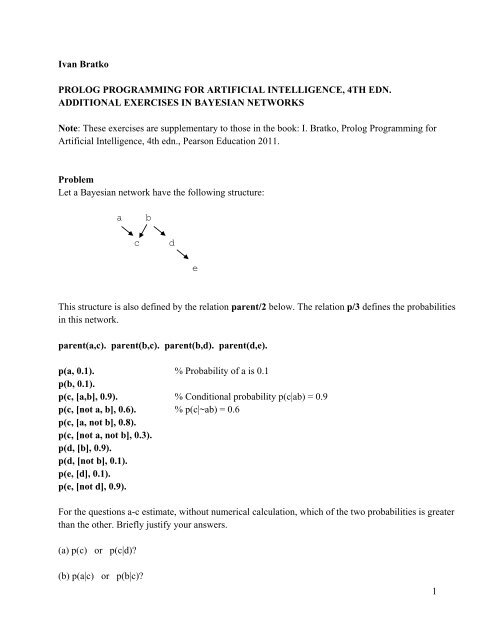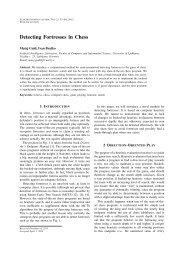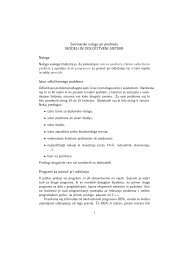Exercises in Bayesian networks
Exercises in Bayesian networks
Exercises in Bayesian networks
You also want an ePaper? Increase the reach of your titles
YUMPU automatically turns print PDFs into web optimized ePapers that Google loves.
Ivan Bratko<br />
PROLOG PROGRAMMING FOR ARTIFICIAL INTELLIGENCE, 4TH EDN.<br />
ADDITIONAL EXERCISES IN BAYESIAN NETWORKS<br />
Note: These exercises are supplementary to those <strong>in</strong> the book: I. Bratko, Prolog Programm<strong>in</strong>g for<br />
Artificial Intelligence, 4th edn., Pearson Education 2011.<br />
Problem<br />
Let a <strong>Bayesian</strong> network have the follow<strong>in</strong>g structure:<br />
a<br />
b<br />
c<br />
d<br />
e<br />
This structure is also def<strong>in</strong>ed by the relation parent/2 below. The relation p/3 def<strong>in</strong>es the probabilities<br />
<strong>in</strong> this network.<br />
parent(a,c). parent(b,c). parent(b,d). parent(d,e).<br />
p(a, 0.1). % Probability of a is 0.1<br />
p(b, 0.1).<br />
p(c, [a,b], 0.9). % Conditional probability p(c|ab) = 0.9<br />
p(c, [not a, b], 0.6). % p(c|~ab) = 0.6<br />
p(c, [a, not b], 0.8).<br />
p(c, [not a, not b], 0.3).<br />
p(d, [b], 0.9).<br />
p(d, [not b], 0.1).<br />
p(e, [d], 0.1).<br />
p(e, [not d], 0.9).<br />
For the questions a-c estimate, without numerical calculation, which of the two probabilities is greater<br />
than the other. Briefly justify your answers.<br />
(a) p(c) or p(c|d)<br />
(b) p(a|c) or p(b|c)<br />
1
(c) p(a|c) or p(a|ce)<br />
(d) Calculate (numerically) the probability p(e).<br />
Answers<br />
(a) p(c) < p(c | d), because d <strong>in</strong>creases probability of b which <strong>in</strong> turn <strong>in</strong>creases probability of c<br />
(b) p(a | c) > p(b | c), because both a and b are a priori equally likely, and a is more likely (than b) to<br />
have caused c<br />
(c) p(a | c) < p(a | c e), because if e then d is less likely, and so is b; s<strong>in</strong>ce c is given, its cause a or b is<br />
needed, and s<strong>in</strong>ce b is less likely <strong>in</strong> the case of e, a must be more likely<br />
(d) p(e) = 0.756<br />
_______________________________________________________________________________<br />
Problem<br />
Consider the follow<strong>in</strong>g <strong>Bayesian</strong> network:<br />
a<br />
b<br />
c<br />
d<br />
Let both a and c be very rare events, and let all the l<strong>in</strong>ks <strong>in</strong> the network correspond to the<br />
causality between events. So p(b | a) >> p(b |~a). Also d is is much more likely when b and/or c<br />
happen. Determ<strong>in</strong>e the relation (, or =) between the follow<strong>in</strong>g probabilities:<br />
(a) p(a) : p(a | c)<br />
(b) p(a) : p(a | d)<br />
(c) p(a | d) : p(a | c d)<br />
(d) p(d | b c) : p(d | a b c)<br />
_______________________________________________________________________________<br />
Problem<br />
Consider the <strong>Bayesian</strong> network:<br />
2
a<br />
b<br />
d<br />
c<br />
Assume there are all the appropriate (conditional) probabilities given for this network.<br />
(a) Derive the formula for comput<strong>in</strong>g the conditional probability<br />
p( c | a) = …<br />
for this network <strong>in</strong> terms of the probabilities <strong>in</strong> the network<br />
(b) Give the formula for comput<strong>in</strong>g p( a | b) for this network.<br />
_______________________________________________________________________________<br />
Problem<br />
The Prolog program below def<strong>in</strong>es a <strong>Bayesian</strong> network. Predicate parent/2 def<strong>in</strong>es the structure of the<br />
network. Predicate p/3 def<strong>in</strong>es the correspond<strong>in</strong>g probabilities.<br />
parent(a,c). parent(b,c). parent(b,d).<br />
p(a, 0.1). % p(a) = 0.1<br />
p(b, 0.1).<br />
p(c, [a,b], 0.9). % p(c | a and b) = 0.9<br />
p(c, [not a, b], 0.1). % p(c | not a and b) = 0.1<br />
p(c, [a, not b], 0.9).<br />
p(c, [not a, not b], 0.1).<br />
p(d, [b], 0.9).<br />
p(d, [not b], 0.1).<br />
Estimate without calculation which probability is higher<br />
(a) p(b) or p(b | d) Expla<strong>in</strong> why.<br />
(b) p(a) or p(a | d)<br />
Expla<strong>in</strong> why.<br />
(c) Calculate the probability p(a | b c).<br />
3
Answers<br />
Diagram helps:<br />
a, 0.1 b, 0.1<br />
c<br />
d<br />
a b p(c) b p(d)<br />
------------- ------------<br />
1 1 0.9 1 0.9<br />
0 1 0.1 0 0.1<br />
1 0 0.9<br />
0 1 0.1<br />
(a) p(b) < p(b | d) because from conditional probabilities for d it follows that b causes d; so know<strong>in</strong>g<br />
d has happened, b is more likely<br />
(b) p(a) = p(a | d) because a is <strong>in</strong>dependent of d (d is a’s non-descendant)<br />
(c) Conditional probability table for c shows that c does not depend on b at all. Therefore:<br />
p(a | b and c) = p( a | c)<br />
Us<strong>in</strong>g Bayes rule:<br />
p(a | c) = p(a) * p( c | a) / p( c) = 0.1 * 0.9 / 0.18 = 0.5<br />
So: p( a | b and c) = 0.5<br />
p(c) = p(a)*p(c | a) + p(not a) * p(c | not a) = 0.1*0.9 + 0.9*0.1 = 0.18<br />
______________________________________________________________________<br />
Problem<br />
Let there be an alarm device <strong>in</strong> a house aga<strong>in</strong>st burglary. We consider three events that can<br />
possibly happen: burglary, storm, and alarm. Alarm may be caused by burglary or storm. We<br />
also have the follow<strong>in</strong>g data: the probability of burglary is 0.001, the probability of storm is 0.01.<br />
Alarm cannot happen on its own (without burglary or storm). Burglary alone causes the alarm to<br />
go on <strong>in</strong> 90% of the cases. Storm alone causes the alarm to go on <strong>in</strong> 1% of the cases. Burglary<br />
and storm are probabilistically <strong>in</strong>dependent, and they <strong>in</strong>dependently cause alarm.<br />
(a) Draw a <strong>Bayesian</strong> network for this problem, so that the network reflects the above stated<br />
causality relations.<br />
(b) Specify approximate values of all the needed conditional and unconditional probabilities for<br />
this Bayes network.<br />
4
(c) Specify exact values of all the needed conditional and unconditional probabilities for this<br />
Bayes network.<br />
Answers<br />
(a) B S<br />
A<br />
(b) p(B) = 0.001, p(S) = 0.01<br />
B S p(A)<br />
-----------------<br />
F F 0.00<br />
F T 0.01<br />
T F 0.90<br />
T T 0.90<br />
(c) Everyth<strong>in</strong>g the same as <strong>in</strong> (b) except:<br />
p(A | BS) = p(A caused by B) + (1-p(A caused by B) * p(A|S) =<br />
0.90 + 0.10*0.01 = 0.901<br />
________________________________________________________________________________<br />
Problem<br />
Consider a <strong>Bayesian</strong> network with nodes A, B, C, D and E. The nodes represent events (that is, their<br />
possible values are just true or false). The structure of the network is:<br />
A<br />
B C D<br />
E<br />
The structure of the network enables the simplification of some conditional probabilities. For example,<br />
p(E | A C) = p( E | C). Here, the condition part AC was simplified <strong>in</strong>to C. In the conditional<br />
probabilities below, how can the condition parts be simplified as much as possible by consider<strong>in</strong>g the<br />
structure of this <strong>Bayesian</strong> network<br />
(a) p( C | ~A B E)<br />
5
(b) p( C | ~A B D E )<br />
(c) p( C | ~B D E )<br />
(d) Express the conditional probability p( B | C) <strong>in</strong> terms of probabilities that must be given by the<br />
def<strong>in</strong>ition of this network.<br />
Answers<br />
(a) p( C | ~A E)<br />
(b) p( C | ~A D E )<br />
(c) p( C | ~B D E ) (not possible to simplify!)<br />
(d) p(B | C) = p(BC) / p(C) = ( p(BC | A)p(A) + p(BC|~A) p(~A) ) / p(C) =<br />
= ( p(A) p(B | A) p(C | A) + p(~A) p(B|~A) p(C|~A)) / ( p(A) p(C | A) + p(~A) p(C|~A) )<br />
________________________________________________________________________________<br />
Problem<br />
(a) Let A, B and C be Boolean variables with possible values 0 and 1, and there is the relation<br />
between these variables such that C = XOR(A,B) (that is C = (A+B) mod 2). Draw a <strong>Bayesian</strong><br />
network and def<strong>in</strong>e the correspond<strong>in</strong>g probabilities for this network which correspond to this<br />
relation. Let the l<strong>in</strong>ks <strong>in</strong> the network <strong>in</strong>dicate that A and B are the causes of C. Let prior<br />
probabilities of A and B be 0.5.<br />
(b) Add to this network two additional nodes, D and K, and the correspond<strong>in</strong>g l<strong>in</strong>ks and<br />
probabilities so that this new network represents the follow<strong>in</strong>g situation. We are test<strong>in</strong>g <strong>in</strong> a written<br />
exam whether a student knows the operation XOR. In the exam problem, the student is given the<br />
values of A and B, an is asked to calculate XOR(A,B). The student’s answer is D. D should ideally<br />
be equal C. But D may be different from C <strong>in</strong> the case the student does not know the topic. Even if<br />
the student knows the topic, the answer may be <strong>in</strong>correct due to the student’s silly mistake. The<br />
variable K = 1 if the student knows the XOR operation, otherwise K = 0. If the student knows the<br />
operation then his/her answer D will be correct <strong>in</strong> 99% of the cases. If the student does not know<br />
XOR, then the answer D will be chosen completely randomly with equal probabilities of 0 and 1.<br />
Let the l<strong>in</strong>ks <strong>in</strong> the <strong>Bayesian</strong> network <strong>in</strong>dicate that C and K are causes of D. The prior probability of<br />
K is 0.5.<br />
(c) Let A=0, B=1 and D=1. Estimate what is, under this evidence, approximate probability that the<br />
student knows the topic: p( K | ~A B D).<br />
6
Answers<br />
(a) 0.5 A B 0.5<br />
A B p(C)<br />
-----------------<br />
0 0 0.0<br />
1 0 1.0<br />
0 1 1.0<br />
1 1 0.0<br />
------------------<br />
(b) 0.5 A B 0.5<br />
C K p(D)<br />
-----------------<br />
0 0 0.5<br />
1 0 0.5<br />
0 1 0.01<br />
1 1 0.99<br />
------------------<br />
C<br />
C K 0.5<br />
D<br />
(c) p(K |~A B D) =<br />
p(K | C D) = p(K) p(CD | K) / p(C D) ≈ 0.5 * 0.5 / 0.375 = 0.6667<br />
p(C D | K) = p(C | K) p(D | C K) ≈ 0.5 * 1.0<br />
p(C D ) = p(K) * p(CD | K) + p(~K) * p(CD | ~K) ≈ 0.5 * 0.5 + 0.5 * 0.5 * 0.5 = 0.375<br />
Here, the calculation was simplified by assum<strong>in</strong>g that if the student knows the topic he/she never<br />
makes a mistake. More precise calculation would give p(K |~A B D) = 0.6644295<br />
________________________________________________________________________________<br />
7





